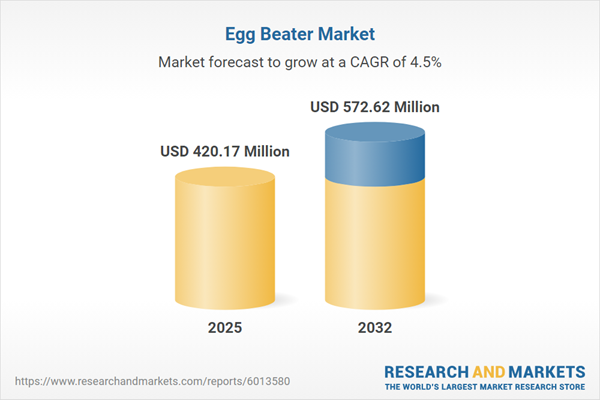Speak directly to the analyst to clarify any post sales queries you may have.
The egg beater market is transforming as innovation, smart connectivity, and sustainability reshape both professional and household kitchen environments. This report delivers actionable insights for senior decision-makers seeking to navigate shifting demand, technology adoption, and evolving distribution models across global markets.
Market Snapshot: Growth Outlook and Drivers
In 2024, the global egg beater market was valued at USD 401.75 million and is projected to reach USD 420.17 million in 2025. The sector’s compound annual growth rate stands at 4.52%, with the market expected to attain USD 572.62 million by 2032. Key growth drivers include rising consumer interest in culinary innovation, escalating demand for ergonomic and automated solutions, and growing digital influence across purchase channels. These trends significantly affect procurement planning and strategic portfolio development among manufacturers.
Scope & Segmentation
This report maps critical market segments and emerging trends, detailing category shifts and technological advancements across geographies:
- Type: Electric (corded, cordless); Manual (balloon whisk, rotary) — capturing evolving usage scenarios and power preferences.
- Distribution Channel: Offline (hypermarket, specialty kitchenware, supermarket); Online (company website, third party e-commerce) — supporting omnichannel strategies.
- End Use: Commercial (bakery, catering, restaurant); Residential (shared household, single household) — reflecting varied feature sets and purchase frequency drivers.
- Price Range: Economy, mid-range, premium — aligning product spec to consumer segment and brand position.
- Material: Plastic, stainless steel — weighing factors of durability, cost efficiency, and environmental impact.
- Technology: Smart (app controlled, IoT enabled); Traditional — integrating digital and mechanical functionality.
- Region: Americas (United States, Canada, Mexico, Brazil, Argentina, Chile, Colombia, Peru), Europe Middle East & Africa (United Kingdom, Germany, France, Russia, Italy, Spain, Netherlands, Sweden, Poland, Switzerland, United Arab Emirates, Saudi Arabia, Qatar, Turkey, Israel, South Africa, Nigeria, Egypt, Kenya), Asia-Pacific (China, India, Japan, Australia, South Korea, Indonesia, Thailand, Malaysia, Singapore, Taiwan).
Key Takeaways for Decision-Makers
- Design innovation and ergonomic performance now define both professional and residential product expectations, influencing procurement and R&D focus across the sector.
- Adoption of electric and smart egg beaters — especially those supporting cordless operation and IoT-based monitoring — is increasing, emphasizing the need for modular product portfolios.
- Omnichannel strategies are essential as consumers value both digital convenience and hands-on in-store experiences, necessitating agile supply chain and distribution models.
- Sustainable materials, such as recyclable stainless steel and biocomposites, are gaining ground in response to regulatory pressures and growing environmental awareness.
- Targeted niche positioning by mid-tier and smaller players enhances brand loyalty through customization and rapid adaptation to evolving culinary trends.
- Strategic partnerships with hospitality and educational organizations foster brand credibility and drive early adoption of technology-enabled models.
Tariff Impact on the Egg Beater Supply Chain
Recent United States tariff measures have necessitated substantial supply chain restructuring and cost management strategies. Increased duties on core components such as stainless steel attachments and precision motor assemblies have led manufacturers to prioritize sourcing realignment and vertical integration. Competitive pricing models have emerged, including co-branding and streamlined product offerings, to maintain profitability amid fluctuating input costs. Small workshops face tighter margins, reinforcing the value of agile procurement and flexible pricing structures.
Methodology & Data Sources
This research leverages a mixed-methods approach for robust market validation. Insights are drawn from industry white papers, trade association reports, patent evaluations, and interviews with procurement leaders, R&D executives, and culinary professionals. Quantitative data incorporates company financials, trade statistics, and e-commerce analysis, with segmentation criteria validated through statistical consistency checks and scenario planning to address market volatility and technological emergence.
Why This Report Matters
- Enables executives to tailor investments and production to changing global market dynamics, supply chain risks, and consumer behavior shifts.
- Provides a comprehensive framework for segmentation, supporting precise product development and commercial strategy alignment across multiple regions.
- Equips decision-makers to anticipate and adapt to regulatory, technological, and distributional inflection points that impact market growth.
Conclusion
The egg beater market’s future trajectory is defined by rapid technological progress, adaptive supply chains, and the pursuit of sustainable practices. Leaders prioritizing digital integration, environmental stewardship, and targeted distribution will be positioned to capture long-term value and resilience in a dynamic industry environment.
Additional Product Information:
- Purchase of this report includes 1 year online access with quarterly updates.
- This report can be updated on request. Please contact our Customer Experience team using the Ask a Question widget on our website.
Table of Contents
3. Executive Summary
4. Market Overview
7. Cumulative Impact of Artificial Intelligence 2025
Companies Mentioned
The companies profiled in this Egg Beater market report include:- Whirlpool Corporation
- Hamilton Beach Brands Holding Company
- Newell Brands Inc.
- Conair Corporation
- De'Longhi S.p.A.
- Groupe SEB S.A.
- Breville Group Limited
- Robert Bosch GmbH
- Koninklijke Philips N.V.
- Spectrum Brands Holdings, Inc.
Table Information
| Report Attribute | Details |
|---|---|
| No. of Pages | 193 |
| Published | October 2025 |
| Forecast Period | 2025 - 2032 |
| Estimated Market Value ( USD | $ 420.17 Million |
| Forecasted Market Value ( USD | $ 572.62 Million |
| Compound Annual Growth Rate | 4.5% |
| Regions Covered | Global |
| No. of Companies Mentioned | 11 |









